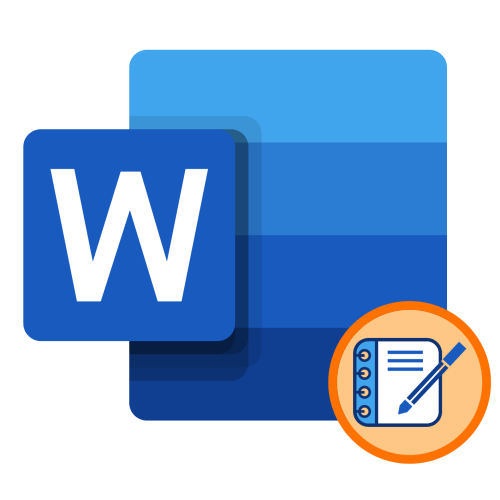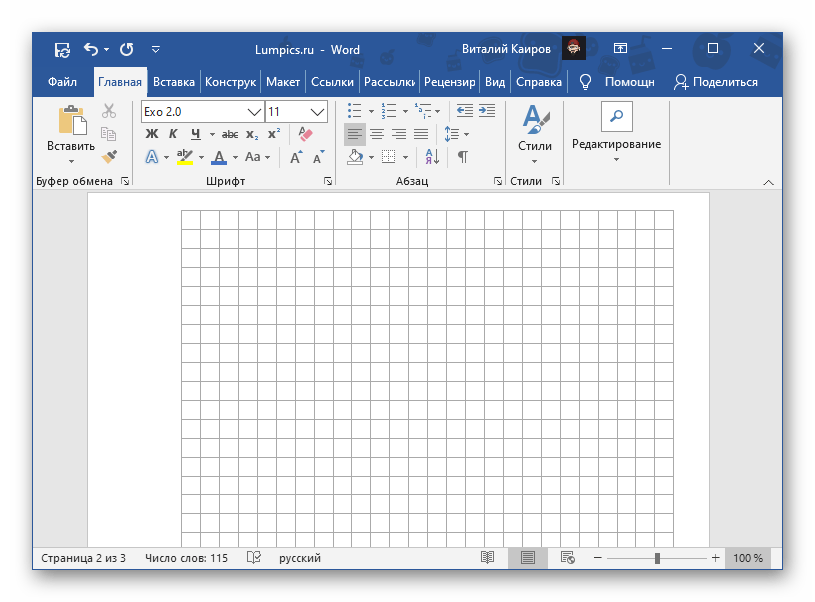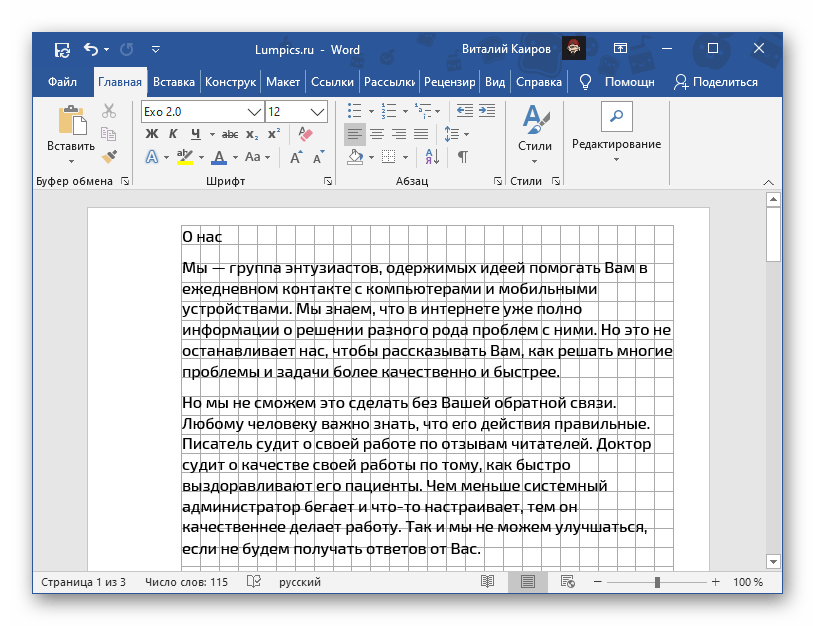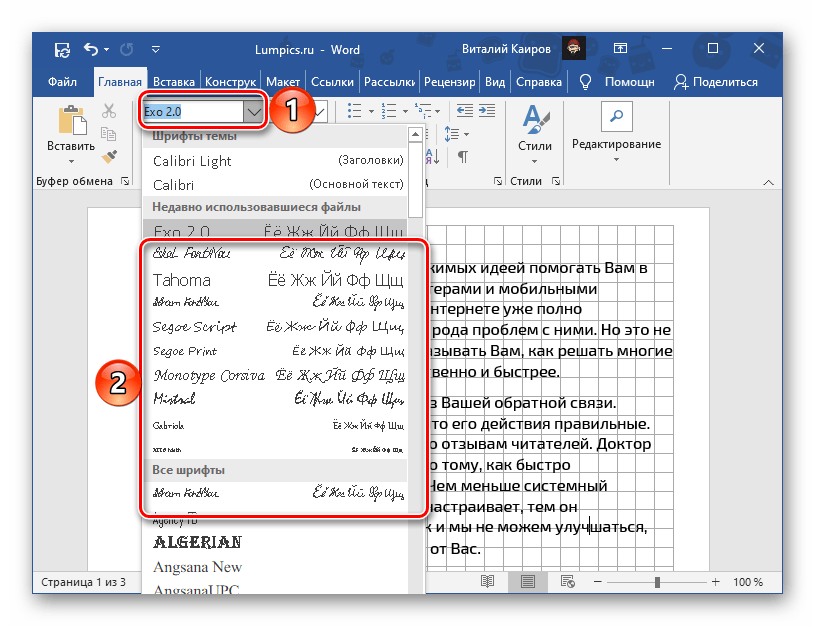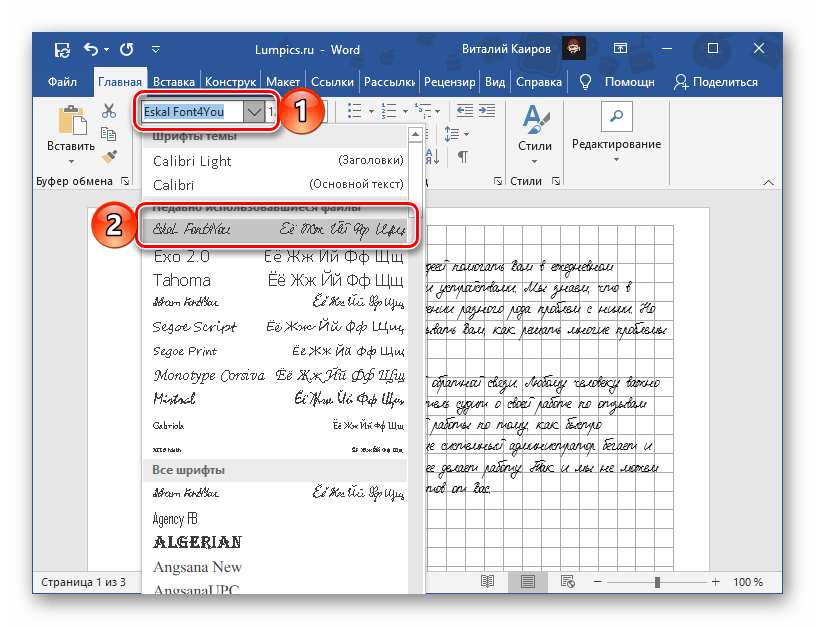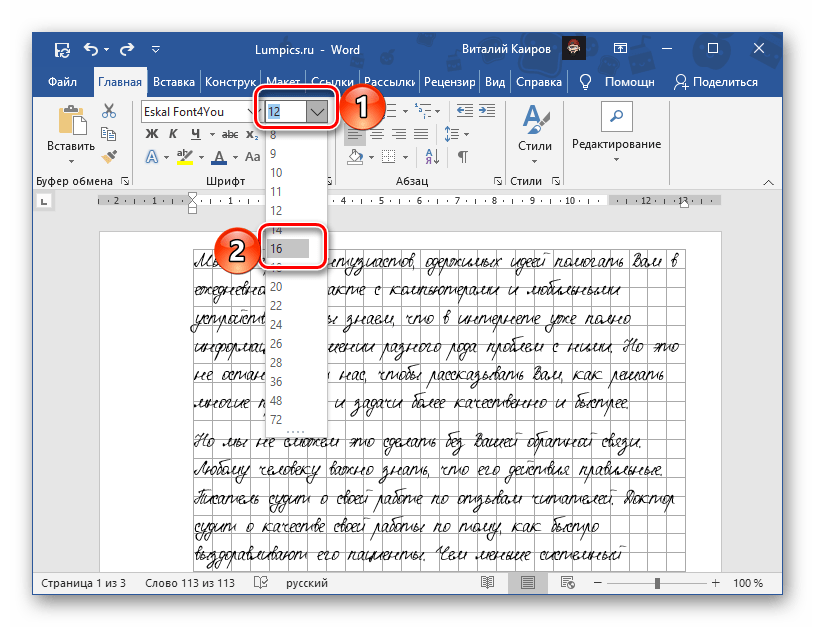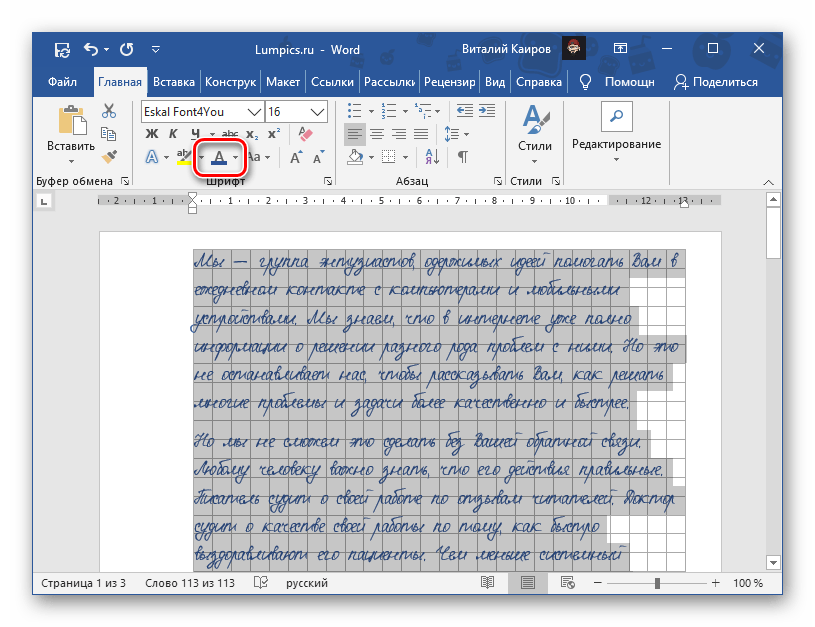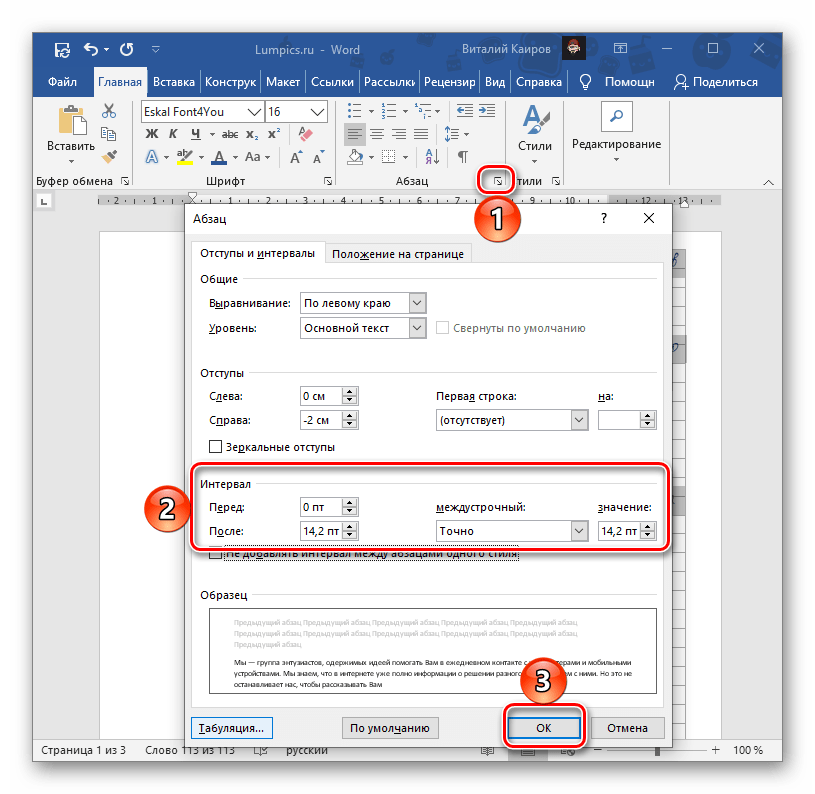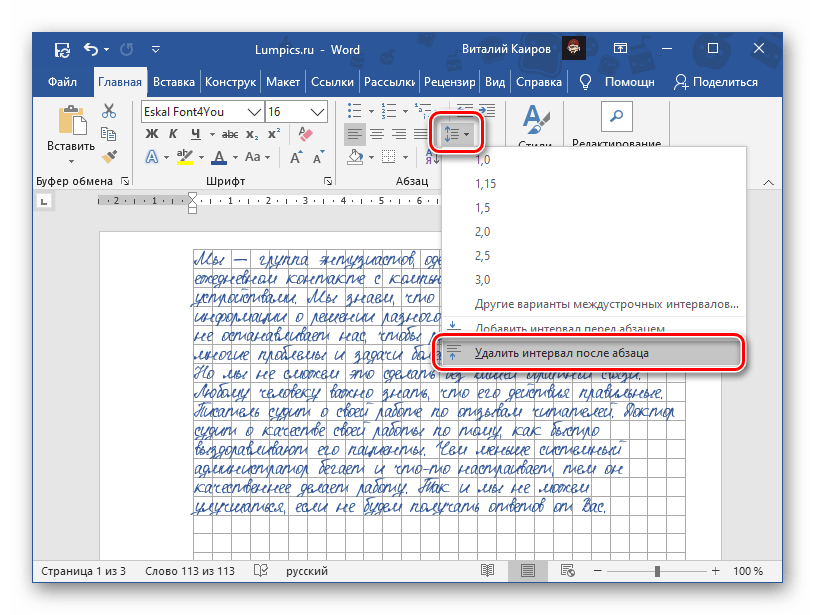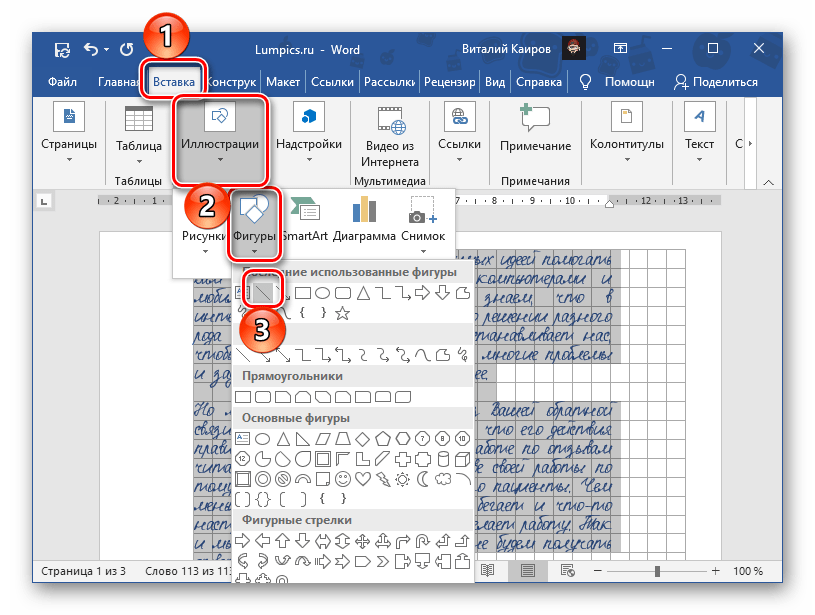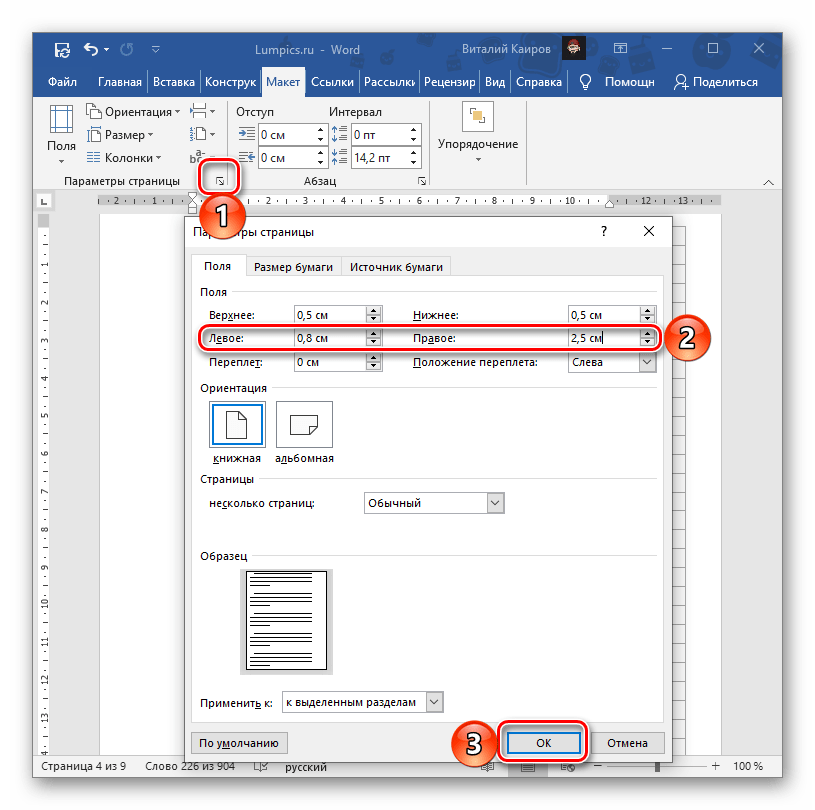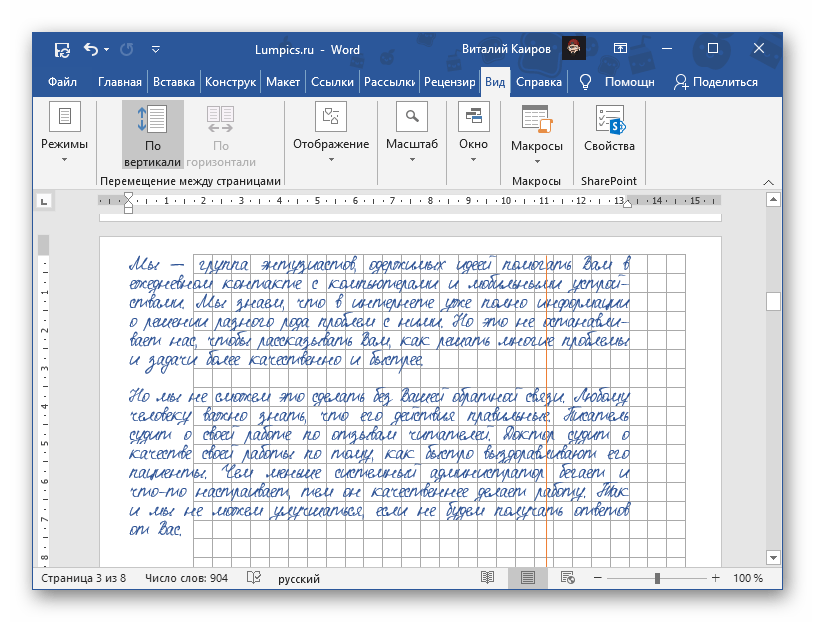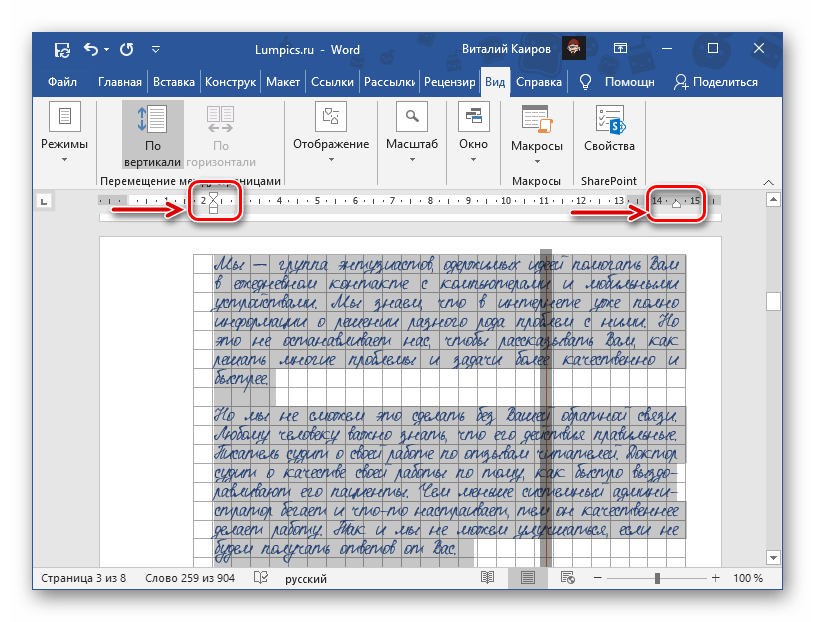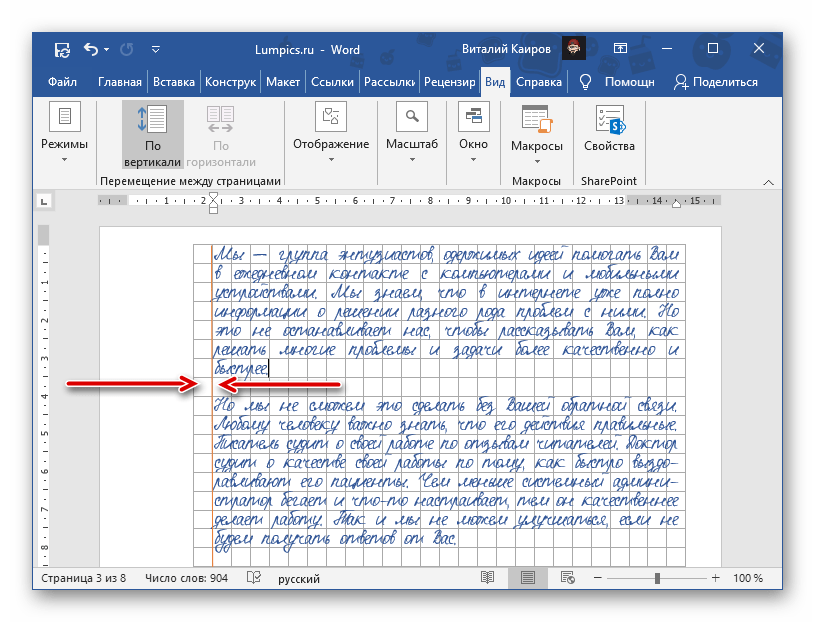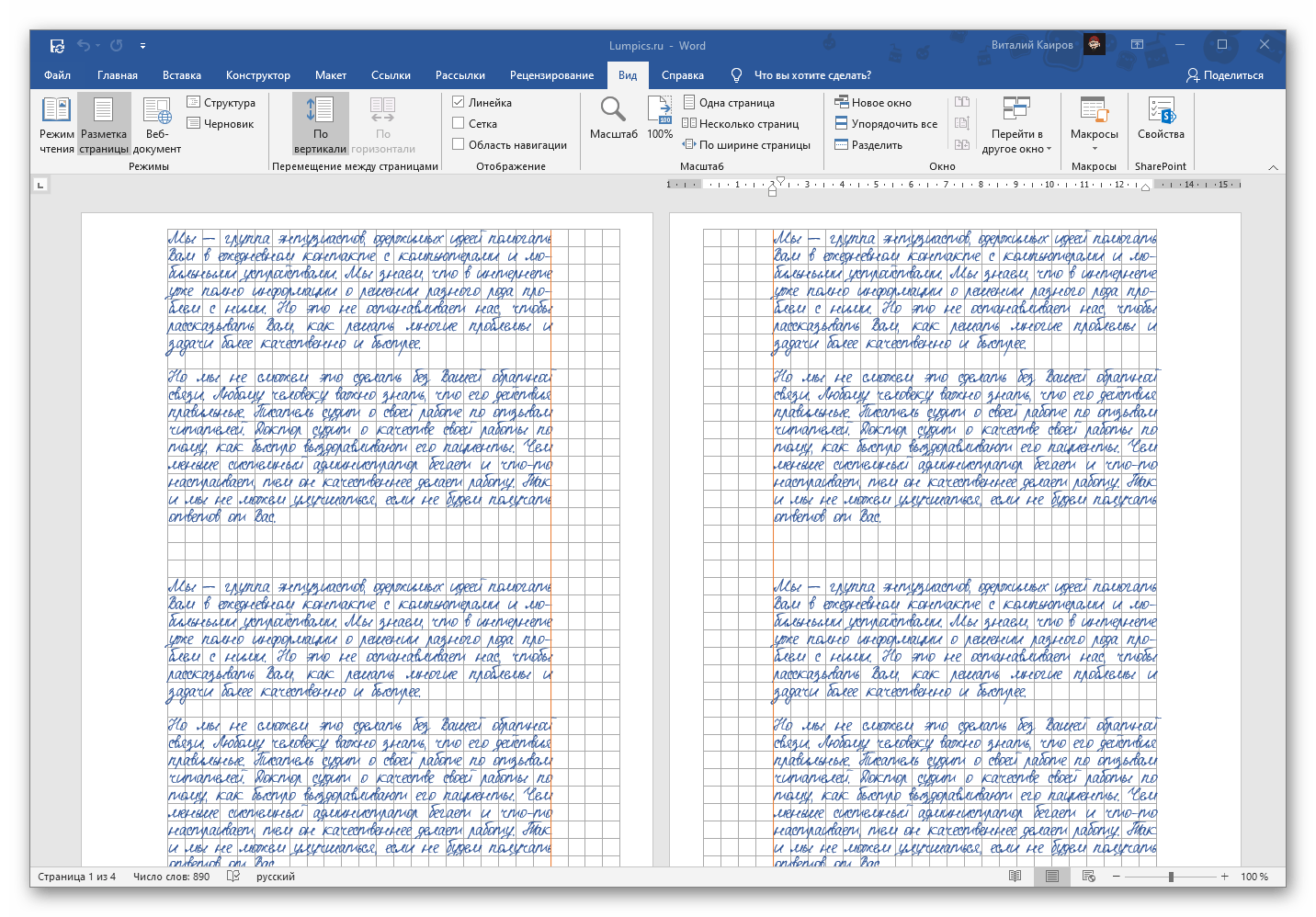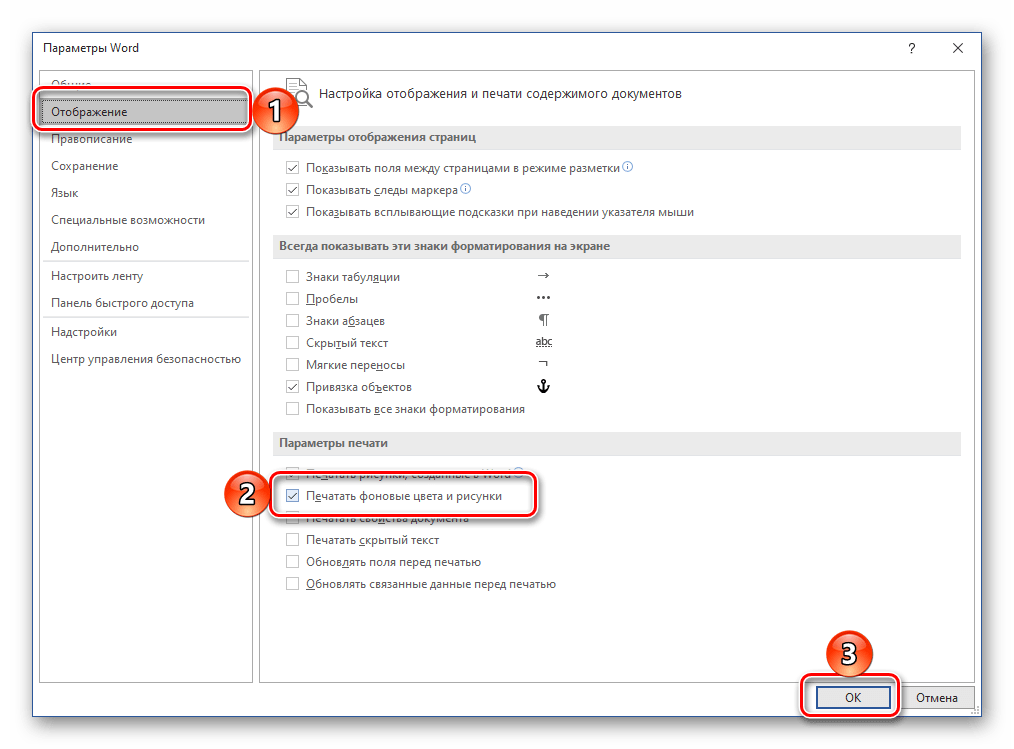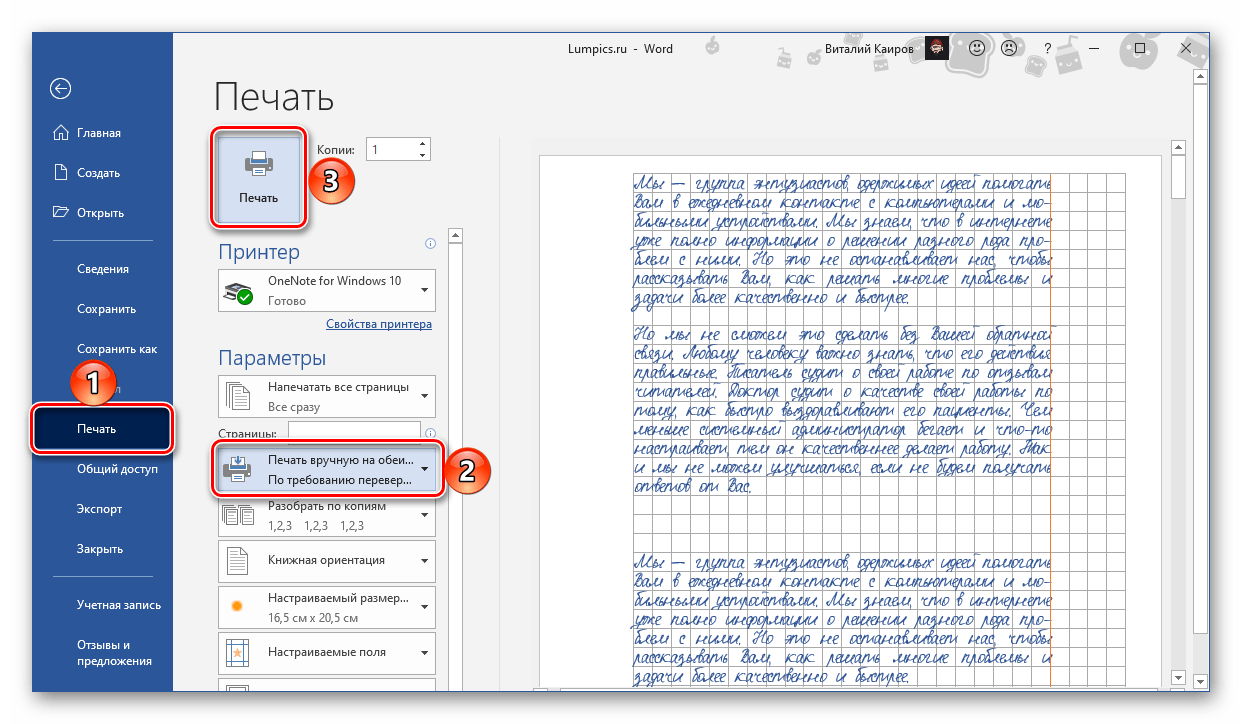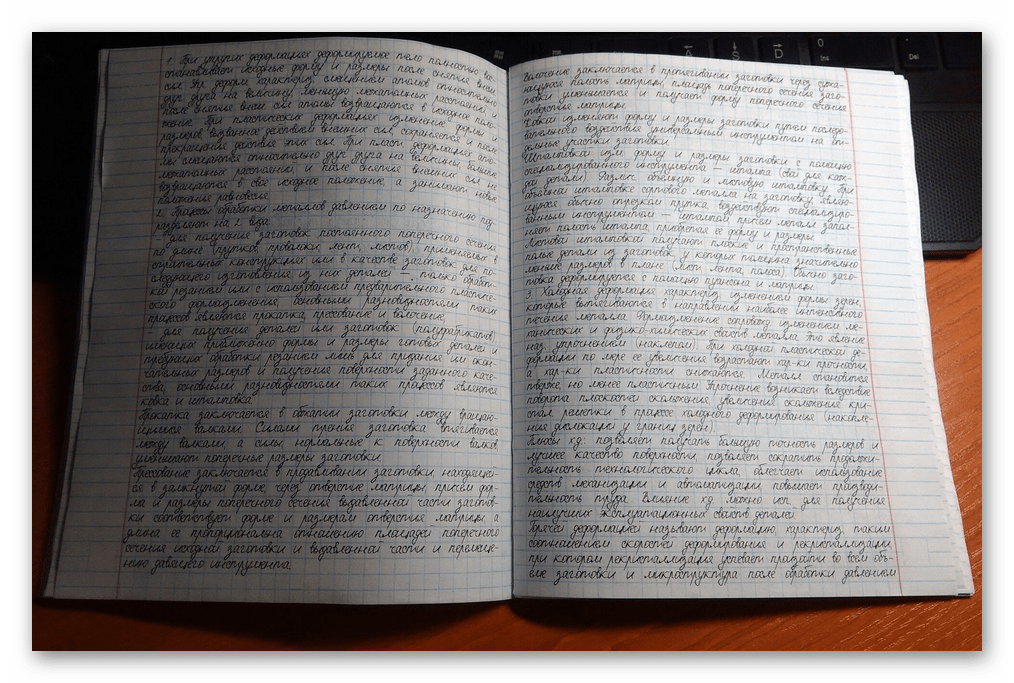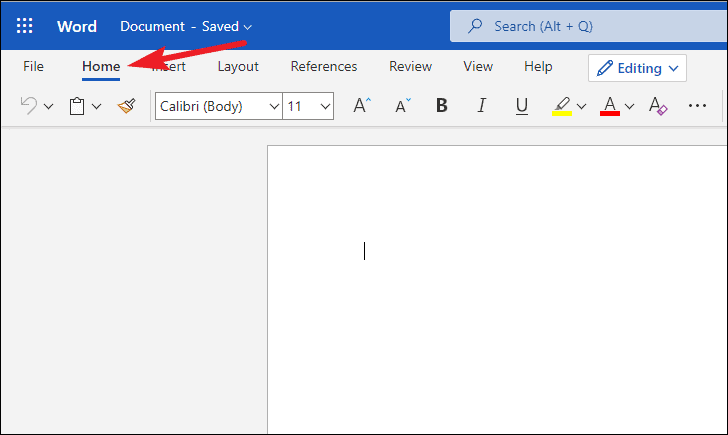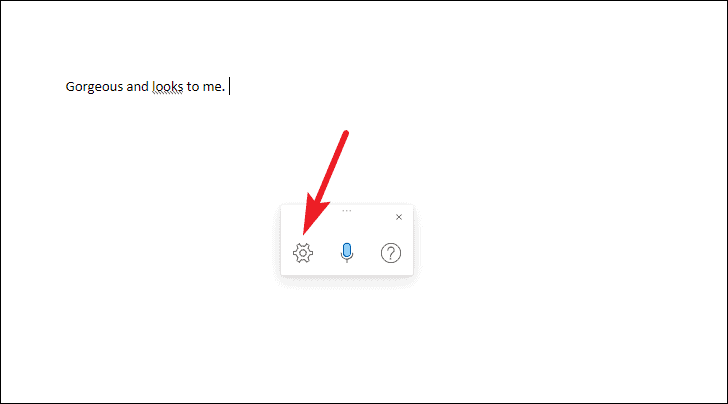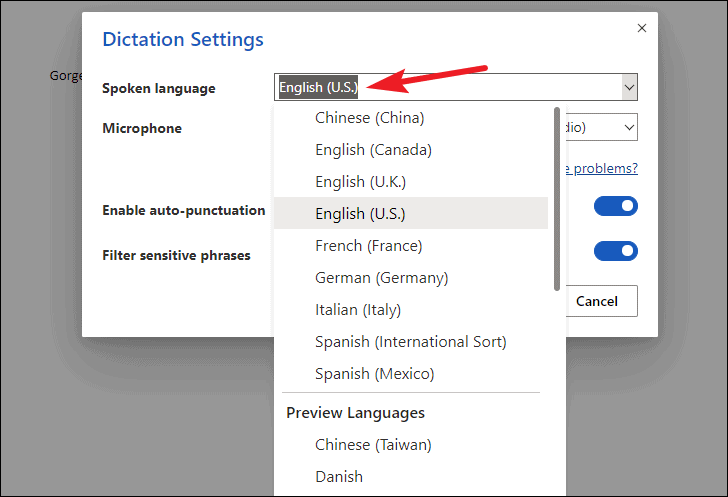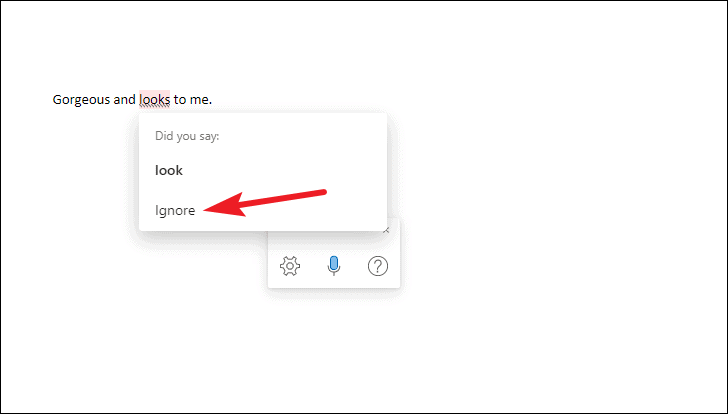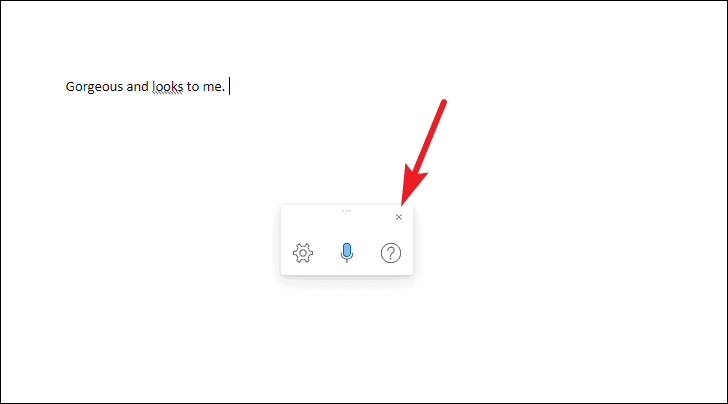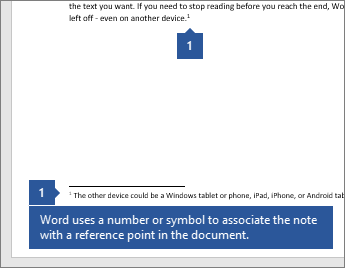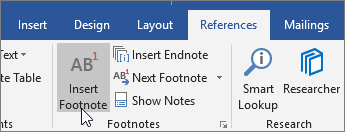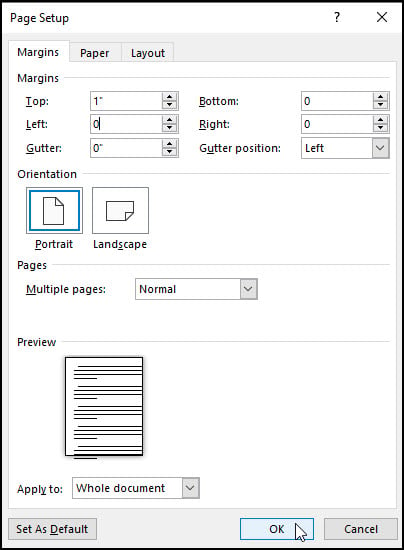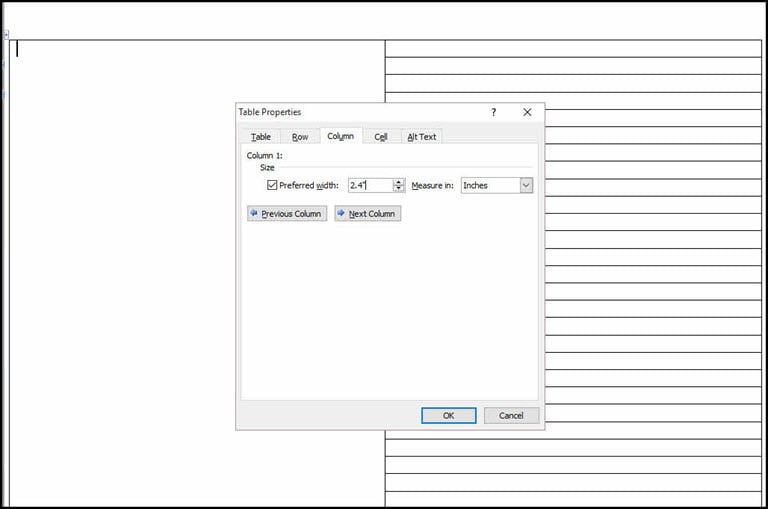Содержание
- Шаг 1: Создание тетрадных страниц
- Шаг 2: Добавление и оформление рукописного текста
- Шаг 3: Печать документа
- Шаг 4: Создание бумажного конспекта
- Вопросы и ответы
Шаг 1: Создание тетрадных страниц
В Майкрософт Ворд можно создать сетку, полностью повторяющую по своему размеру и виду клетку на тетрадных листах. Однако для того, чтобы сделать ее одновременно пригодной и к набору текста, и к печати на принтере, необходимо прибегнуть к некоторым хитростям. О том, как создать подходящий для решения нашей задачи макет, мы ранее рассказывали в отдельной статье – ознакомьтесь с ней, выполните предложенные рекомендации, и только после этого переходите к следующему шагу.
Подробнее: Как сделать тетрадный лист в Word
Шаг 2: Добавление и оформление рукописного текста
Важно! Все дальнейшие манипуляции необходимо выполнять исключительно при масштабе страницы 100%, иначе и клетка, и другие элементы, используемые в документе Ворд, будут отображаться некорректно.
- Имея на руках точную электронную копию тетрадных листов, необходимо добавить на нее текст будущего конспекта и правильно его оформить. В качестве примера используем запись со страницы «О нас» сайта Lumpics.ru.
- Выберите в перечне предустановленных в Word шрифтов один из тех, который, по вашему мнению, максимально похож на рукописный (обратите внимание на то, что далеко не все из них поддерживают русский язык).
Читайте также: Как изменить шрифт в Ворд
Однако значительно лучшим решением в данном случае будет установка стороннего шрифта, максимально приближенного к естественному почерку. Со своей стороны можем порекомендовать сайт Font4You, автор которого занимается созданием именно таких шрифтов. О них мы рассказывали в отдельной статье.
Подробнее: Как сделать рукописный шрифт в Word
Важно! В качестве наглядного примера далее мы будем использовать шрифт Eskai, входящий в библиотеку Font4You. Вы же можете выбрать любой другой, но учтите, что все дальнейшие рекомендации касательно размера, интервалов, отступов и прочих параметров применимы строго к Eskai, в остальных случаях может потребоваться настроить их самостоятельно.
- Окончательно определившись с выбором и добавив в документ Ворд текст, вид которого вы хотите преобразовать, выделите его и примените к нему рукописный шрифт.
- Установите размер 16.
По желанию также можно изменить цвет из стандартного черного на синий, приближенный к таковому в обычной шариковой ручке.
Читайте также: Как изменить размер и цвет шрифта в Word
- Не снимая выделения с текста, нажмите по нему правой кнопкой мышки и выберите пункт «Абзац». Интервал «После» задайте 14,2 пт, междустрочный выберите «Точно» и введите в поле «значение» 14,2 пт. Нажмите «ОК» для подтверждения.
Важно! Если вы хотите, чтобы текст в будущем конспекте был записан не в каждой строке, а через одну, для междустрочного интервала необходимо установить значение 28,35 пт.
- Чтобы выровнять весь «рукописный» текст по одной линии, снова выделите его, нажмите на кнопку «Интервал» и выберите пункт «Удалить интервал после абзаца».
Важно! В определенных местах будущего конспекта наверняка потребуется добавить отступы – интервалы между абзацами. При заданных нами параметрах один отступ по высоте равен одной клетке, но в некоторых случаях их может потребоваться настроить отдельно. Сделать это помогут следующие инструкции на нашем сайте.
Подробнее:
Как изменить междустрочный интервал в Ворд
Как убрать интервал меду абзацами в документе Ворд - Выровняйте текст по ширине страницы.
Читайте также: Как выровнять текст по ширине страницы в Word
На данном этапе также можно добавить поля. Для этого включите отображение линейки в документе, если этого не было сделано ранее, выделите весь текст и сместите его влево от правой границы на несколько клеток.
Читайте также: Включение и использование линейки в Ворд
Вертикальную черту, обозначающую выделенные нами поля, придется на каждой странице документа рисовать вручную – проще всего это сделать с помощью вставки фигуры – линии.
Читайте также: Как нарисовать линию в Word
Разместите ее на подходящем расстоянии между текстом и правым полем, измените цвет на красный, а затем выполните это же на каждой последующей странице документа.
- Опционально в текст можно также добавить автоматический перенос слов.
Читайте также: Как сделать перенос слов в Ворд
- Так как создаваемый нами макет в дальнейшем будет собираться в тетрадь, необходимо подкорректировать размеры полей для каждой второй (четной) страницы, отразив их. Для этого:
- Выделите текст на второй странице документа и перейдите во вкладку «Макет».
- Проделайте эти же действия с каждой последующей четной страницей в документе
Вызовите меню группы инструментов «Параметры страницы» и поменяйте местами значения левого и правого полей. Нажмите на кнопку «ОК» для подтверждения.
- Последнее, что необходимо сделать — восстановить расположение текста на страницах относительно тетрадных полей. Для этого:
- Либо сразу выделите все четные страницы документа, либо, если выделите только одну, затем все необходимые действия придется повторить для каждой из них.
Читайте также: Как выделить одну страницу в документе Word
- С помощью линейки сместите текст вправо — на одинаковое расстояние от левого поля и к правому, то есть сделайте так, чтобы он по своему виду был зеркальным отражением того, что вы видите на нечетных страницах.
- Если добавляли линию поля, переместите ее с правой стороны на левую.
- Выполнив все эти действия, пролистайте документ и убедитесь, что четные и нечетные страницы в нем выглядят так же, как соответствующие стороны тетрадного листа.
- Либо сразу выделите все четные страницы документа, либо, если выделите только одну, затем все необходимые действия придется повторить для каждой из них.
- Сохраните полученный макет конспекта и переходите к следующему этапу.

Шаг 3: Печать документа
Последнее, что остается сделать с электронной версией документа – распечатать ее на принтере. Но прежде необходимо активировать отображение фона страницы, которое по умолчанию не выводится на печать.
Вызовите «Параметры» текстового редактора, откройте вкладку «Отображение» и установите отметку напротив пункта «Печатать фоновые цвета и рисунки», после чего нажмите «ОК».
Далее перейдите в раздел «Печать», вместо односторонней выберите «Печать вручную на обеих сторонах» и запустите процесс.
Важно! Обязательно учитывайте то, как располагаются «расчерченные» поля на страницах.
Подробнее: Печать документов в Ворд
Шаг 4: Создание бумажного конспекта
Соберите распечатанные листы, склеив их тонкой полоской скотча и сделав иголкой отверстия в тех местах, куда должны входить скобы. Лучше делать их в соответствии с расположением на предварительно подготовленной обложке, «позаимствованной» у настоящей тетради. В нее же и следует облачить полученный в результате конспект, вставив скобы в проделанные отверстия и согнув их. В идеале должно получиться нечто похожее на изображение ниже.
Еще статьи по данной теме:
Помогла ли Вам статья?
Taking notes during a class can be complicated. Often, it’s all going too fast for you to jot it down. There are even moments where you have to decide between being fully present and understand the lecture or write it down for future reference but at the expense of complete understanding.
These challenges only get magnified in online classes. It’s already too difficult to focus in virtual classes. What with a completely different setup than a normal classroom and other constraints of a “virtual meetup”, everyone knows virtual classes are overwhelming, whether you are a younger or an older student. Now, add note-taking to the mix, you’ve got a recipe for disaster at your hands.
Fortunately, with Microsoft Word, the crisis can be averted firmly. You can dedicate your focus to being present in the class and let Word take care of the notes for you. We’re talking about the Dictate tool here. Sounds intriguing, doesn’t it? Let’s jump right into the details.
What is the Dictate tool in Microsoft Word?
Microsoft Word’s wonderful feature, Dictate, can convert the speech into text on your Word page. Dictate is available across devices – Windows, Mac, iOS, Android, and even the Web. So, you can use it no matter the type of device you’re using to meet.
Dictate is available for nearly 20 languages with more set to come in the future. The supported languages include:
- English (United States)
- Chinese (China)
- English (Canada)
- English (United Kingdom)
- German (Germany)
- Italian (Italy
- Spanish (Spain)
- Spanish (Mexico)
- Danish
- Dutch (Netherlands)
- English (Australia)
- English (India)
- Finnish
- French (Canada)
- Japanese
- Norwegian (Bokmål)
- Portuguese (Brazil)
- Swedish (Sweden)
Some of these languages (the latter part of the list from Dutch to Swedish) are still in preview, though. So, dictation may not be entirely accurate sometimes or punctuation may be limited.
Dictate is available on Microsoft Word for Web for free. But for the Windows and Mac desktop apps, the tool is only available to Microsoft 365 subscribers.
Using Dictate in Microsoft Word
Open Microsoft Word, either the desktop app if you’re a Microsoft 365 subscriber, or in Chrome, Edge, or Firefox browsers if you’re using Office for Web. Log in to your Microsoft account if you’re using Word Online.
Now, go to the ‘Home’ tab from the menu bar.
From the Home tab, go to ‘Dictate’. Instead of Dictate, the toolbar might have only the ‘Microphone’ icon but it’ll say ‘Dictate’ when you hover over it. Click the icon to start dictating.
Note: When using a Windows PC, you can also the Alt + ` (backquote) keyboard shortcut to turn on Dictate.
For web users, if you’re using dictation for the first time, you’d have to provide browser access to your microphone. Click ‘Allow’ from the pop-up box that appears.
The Dictate tool will become active. You’ll know as a small pop-up box with a Microphone will appear on the screen. You can move it around on the screen anywhere. The Microphone will have a red dot when it’s actively listening.
To change the language of the dictation tool, go to the Dictate pop-up and click the ‘Settings’ (gear) icon.
The dictation settings window will open. Click the drop-down menu next to the ‘Spoken Language’ option and select one of the available languages.
Now, you can enter punctuation or start a new line by dictating those commands explicitly. Generally, it’s as good a way as any. But when using Dictate to take notes, it’s best to turn on auto-punctuation. To enable ‘Auto-punctuation’, go to Settings for Dictate.
From the options that appear, turn on the toggle for ‘Enable Auto-Punctuation’. Auto-punctuation might not always be spot-on, especially for Preview languages. But it’ll still make your notes more legible than no punctuation at all.
Dictate also has a filter for sensitive phrases that is on by default. It automatically masks potentially sensitive words or phrases with ****
Sometimes, markings may appear under some words. They indicate alternatives that Word may have misheard. When you click it, suggestions will appear. You can choose one of the suggestions, or click ‘Ignore’ if it was already correct.
You can also correct anything using your keyboard without stopping the dictation.
To pause the dictation, click the Microphone from the pop-up. To exit dictation, click the ‘Close’ (X) button on the Dictate pop-up.
Note: Dictation might stop if the Word window is not active on the screen. So, place your meeting and Word windows side-by-side for this to work perfectly.
There you go! A perfect way to take notes in your online classes, just make sure that you’re using the speaker and not headphones to listen to the meeting. Of course, you can use the tool in not just online but in normal classes as well.

… Jetta Productions/Digital Vision/Getty Images
Reviewing your notes and reading assigned texts can help you master the materials in the classes you’re taking — but if you want another way to study, create your own study guide. Study guides often come with information packaged in a number of different formats, such as visuals, outlines, summaries, and basic charts. Try using all of these methods when you create a study guide in Microsoft Word.
Launch Microsoft Word and select «Blank Document» from the template chooser.
Type the name of the class, section, or something else that denotes the study topic at the top of the page. Throughout the document, make your headings larger by highlighting the text and then selecting a number larger than «12» from the Font Size drop-down menu.
Make an outline of important information from your class notes. Microsoft Word helps you format the outline as you go. Start by typing «I,» and then type a main heading; pressing «Enter» will automatically insert «II» below your heading, but if you press «Tab,» Word removes the «II» and inserts an indented «a.» Type a subheading, press «Enter,» and then either type another subhead or press «Tab» to add more detailed information underneath the first subhead. For example, if you’re studying anatomy, you might type «Leg Muscles» for the heading, type «Quadriceps» next to «a,» create subheadings under «Quadriceps» to type the names of the four quadriceps muscles, and then type «Hamstrings» next to «b.»
Create a visual organizer of information using images and text boxes. This way you can include such things as diagrams, maps and photos in your study guide. With the Insert tab open, click «Insert» and then «Picture» to locate and insert a photo from your computer. Following our example of a study guide for muscles, you might insert a picture to help you remember what the quadriceps look like and where they are located in the body. With the Insert tab still open, click the «Text» group and then click «Text Box» to add text to the page. Click the border of the text box to move it to an appropriate location on the document, and click and drag one of its corners to change the size of the box if necessary. Type the basic concept you’re studying in the text box, such as «Leg Muscles,» and type additional information to help you study or create another text box with related details.
Create a table that you can use to study important words or study questions. Place your cursor on the part of the document where you want the table to go. With the Insert tab selected, click «Table.» From the menu that appears, pull your cursor across and down to select three columns across and the number of rows that correspond to the number of words you need to study. For example, if you have 10 vocabulary words or study questions, move your cursor down 10 rows. When the desired number of rows and columns is highlighted, click your mouse to create the table. Type the vocabulary words or questions in the rows along the left side of the table, leave the middle column blank, and type the definitions or answers in the corresponding cells along the right hand side of the table. When you print this portion of the study guide, you can fold the paper along the middle column, or leave the right half covered so you won’t see the definitions or answers until you’re ready.
Click the disk icon near the top left of the Word window to save your document. In the window that appears, type the name of your study guide and click «Save.» When you want to print the document, click «File,» and then select «Print.»
About the Author
Nicole Vulcan has been a journalist since 1997, covering parenting and fitness for The Oregonian, careers for CareerAddict, and travel, gardening and fitness for Black Hills Woman and other publications. Vulcan holds a Bachelor of Arts in English and journalism from the University of Minnesota. She’s also a lifelong athlete and is pursuing certification as a personal trainer.
Insert footnotes and endnotes
Footnotes appear at the bottom of the page and endnotes come at the end of the document. A number or symbol on the footnote or endnote matches up with a reference mark in the document.
-
Click where you want to reference to the footnote or endnote.
-
On the References tab, select Insert Footnote or Insert Endnote.
-
Enter what you want in the footnote or endnote.
-
Return to your place in the document by double-clicking the number or symbol at the beginning of the note.
Need more help?
Want more options?
Explore subscription benefits, browse training courses, learn how to secure your device, and more.
Communities help you ask and answer questions, give feedback, and hear from experts with rich knowledge.
Cornell notes templates are commonly used by students in universities to capture key points from a lecture. Cornell’s notes-taking method is one of the most effective ways to gather information efficiently. Dr. Walter Paulk from Cornell University introduced this effective method of note-taking. Download free Cornell notes templates to organize your study notes in Word (doc or Docx), Excel, and PDF formats. In this article, we share all the things that you should know to make your notes organize and summarize.
- Accounting Templates
- Art & Media
- Budget Templates
- Business Templates
- Calendar Templates
- Certificates
- Charts
- Education Templates
- Inventory Templates
- Invoice Templates
- Letter Templates
- Medical Templates
- Personal Templates
- Project Plan Templates
- Timesheet Templates
What Are Cornell Notes?
There are various note-taking methods that you can use to organize your notes. But the Cornell note-taking method is one the most popular and efficient techniques to improve your study skills and draft your study notes in an organized way. This method is commonly used by students of universities and colleges to record important information during a lecture.
Download Free Cornell Notes Templates
It is also helpful in many situations to note some key points. Students use different tips and strategies to improve their study habits. Time management, note-taking, test-taking, and strictly following the lesson plan are one of the essential strategies that are followed by every successful student. It is not possible to write down all the words that you listen to in a lecture. So it is essential to follow an effective way to understand the whole concept in a few lines. The memory of some students fades quickly; it is the most efficient way to learn knowledge from a lecture, not just to memorize it.
Writing essential key points efficiently helps to memorize things for a long time because researchers say people forget 50% of what they listen to in an hour. So note-taking is a beneficial strategy to memorize the essential key points that you can use for future reviewing. Below we share a complete guide to Cornell notes-taking methods to organize your notes in a structured form. It is very helpful to see Cornell notes example templates to understand more about it. You can also find Cornell notes templates in a standard format. These printable note-taking templates are free and available in every format like Word, Excel, and PDF.
Cornell Notes Taking Method
There are many techniques of note-taking, but Cornell notes taking method is one of the best. The Cornell note-taking process helps you to understand more about it. Follow these simple steps to make your notes organized:
Prepare your notebook
Prepare your notebook or paper according to the Cornell note-taking format.
- First of all, a horizontal line at the bottom of the page that must be 5-7 lines above the last to make a portion in the last of the page to write the summary of your notes.
- Draw a vertical line from the start to the horizontal line that you draw.
- The left part of the page must be 2.5 inches used for reviewing your notes. It is called the clue column.
- Whereas the right portion of the vertical line is used for note-taking.
Make the header of this page, and write the name of the lecture topic at the top of the note-taking page. It will help you to identify each page with the name of the lecture topic.
Clue column
- Underline all the key points in the note-taking section and then write the essential key points or keywords in the left part of the paper.
- Place related questions, comments, keywords, and main ideas in this section of the paper.
- Formulate all the test questions from the note-taking section and write them in the clues column.
- This column is used to review your notes and helps to take a self-test.
Note-taking section
- Write information that the professor gives in a lecture or reading book and from other resources.
- Include diagrams displayed on the board while listening to lectures.
- Write all of your notes in the right-hand section of the paper in detail.
- Use bullet points and paragraphs to make them readable.
- Follow the MLA format to make it more comprehensive and understandable for the future.
- Write as simply and descriptively as possible.
Summary
- Write the summary of your notes in your own words.
- Use a few lines to summarize all the things.
- It is written after the lecture or writing the clues column and note-taking section.
- Include important information in the summary section.
To write the summary of a lecture, see the free Cornell notes summary templates in Word and PDF format.
It is one of the fastest ways to organize your notes, improve learning skills, and summarize all the essential things in one place. If you want to take all the advantages of this method, then it is essential to follow the Cornell notes format. Browse our collection to download the Cornell notes sheet, which is available in every version you prefer according to the Cornell layout.
The 5 R’s Of Note Taking
The primary reason for the note-taking method is to improve your study skills and help you make successful in your field. Above, we discussed one of the most popular and effective techniques of note-taking. After that, there are some things that you should keep in mind to use these notes efficiently. The Cornell system is explained by the following things:
Record
The first R’ of note-taking defines recording all the essential things during a lecture. Write all the meaningful data. Record the important points, facts, and ideas which you are listening to in a lecture or reading from a book.
Reduce
It is hard to write down all the words of your professor during a lecture. Try to summarize things as you can. Underline the essential things in your note-taking section and write the keywords, questions, and ideas in the clue section of the paper. It helps to make things clear and understand quickly.
Recite
To memorize all the things, it is essential to write your notes in your own words. Read the note-taking section, see the cue column, and then write what you listen to in a lecture in a few lines.
Reflect
Think about this topic after reading your notes and write your ideas in the notebook, which helps to make a better discussion about this topic and able you to make better answers to the exam question.
Review
Before reading further about the same topic, take review your old notes. It helps to refresh all the information that you have in your old records. Take a review of the key points and main ideas before adding the new material to your old notes.
Features Of Good Notes
There are features of good notes from which you must be aware of making effective notes:
- Should be organized in an efficient way
- Must be followed by some note-taking method
- Use bullet points instead of a long paragraph
- Should be readable and understandable
- Underline the key points and main ideas
- Use graphics to make it visually better
- There should be a header for the notes
- Use the standard margin and line spacing
- Use paragraph headings to make it more descriptive
- Include the relevant information
You should have all these features in your notes to call them good notes.
5 Best Note-Taking Methods
There are various note-taking methods that you can follow to make your notes well organized. Students use different techniques to arrange notes and improve their study skills. One of the most popular and effective techniques is note-taking. Cornell note-taking system is one of the popular and commonly used notes taking methods. Below we provide a complete guide to the basic note-taking methods. Some primary methods to improve the readability of your notes are as follows:
The outline method
The outline method is one of the popular and effective methods to write down what you heard in a lecture. This method is helpful when there is group information. After discussing the main topic, there are subcategories of the main topic. It is vital when you write down the information in a structured form. Use bullet points to represent every topic and the sub-topic. You can see an outline method example to understand its format of it.
The boxing method
In the boxing note-taking process, each box contains a specific group of information. Students do not commonly use the boxing method because it is time-consuming. Grouping the data in different tables is sometimes time-consuming and complicated. It is not suitable to note down every type of information.
The Cornell method
Above, we discuss all the Cornell notes and its method. Divide your paper as we described above, and write the brief information but to the point in the note-taking section. Summarize your notes and write them in the summary section. Place the key points, main ideas, and questions in the cue column to self-test and review notes.
The charting method
The charting method is just like the table and spreadsheet. Organize your notes by creating the chart. Make a separate row for each topic and place the related information in each cell. There are different categories of each topic that are placed in each column. For example, charting note-taking methods and columns of this topic may be described, advantages, disadvantages, and uses.
The mapping method
The mapping method is used when the material of your notes is complicated and hard to write. Students or teachers use a mapping note-taking approach to represent the content graphically. Write the main topic on the top of the page and write the related topic or subtopics on the left or side and link it with the main topic by drawing the arrows.
How To Format Cornell Notes Template In Word
We share a list of Cornell note-taking format templates available in every format which you like. You can customize blank Cornell notes templates as you need. Follow these steps to make your template in Word:
- Open Microsoft Word.
- Click on the “Blank document” to make the template according to your need.
- Make a header of the document as you like, you can write as “class notes templates.”
- Go to the “insert tab” click on “table” and select the drawing table.
- Draw a table according to your need. People prefer the unlined Cornell template; you can draw it as you like. It should be 2.5 inches for the left side of the clue column and 6.0 inches for the notes-taking section and 2.0 inches for the summary part of the notes.
- Click on the “file” from the menu bar. Select “save as” and write the name of the file then click “ok” to save it.
Tips For Cornell Notes Taking
Use these tips to make your notes useful.
- Use bullet points to highlight the essential key points.
- Write all the important information briefly but to the point.
- Listen to the lecture actively.
- Summarize the whole lecture notes in our own words
- Write your opinion in the summary section after listening to the lecture.
- Underline the important points and draft questions, main ideas, and key points from the note-taking section and write in the left-hand side column the paper
- Use simple words for complex terms.
Use MLA format to increase the readability of your notes.
Mistakes To Avoid While Taking Cornell Notes
Cornell’s notes-taking system is widely used by the students of schools and colleges for biology, maths, and chemistry subjects. Mistakes that commonly happen while taking Cornell notes, we share a complete guide to avoiding these mistakes.
- It is impossible to write down the lecture without listening to it. People focus on writing instead of listening to the lecture attentively. This may lead to making failure notes.
- Students want to write down every word of the lecture, avoid it. Write only the important and relevant information in your notes. Avoid writing irrelevant things in your notes.
- Sometimes, students follow the paragraph strategy to note the lecture. It may create confusion and is difficult to read. Instead, use bullet points to highlight the essential things.
- Students write the content of the lecture and then forget to review it. Reviewing the notes helps to memorize them and prevent any incorrect information.
- Taking notes does not mean highlighting the text. It is a way to summarize the lecture in an organized and efficient way.
Liked it? Take a second to support Zara Gregory on Patreon!
Download Article
Multiple easy-to-follow ways to add footnotes in Word
Download Article
Footnotes allow you to cite sources or explain a concept in detail without sidetracking the main text. Word makes managing footnotes easy, as new footnotes are numbered automatically, and the footnotes area expands and shrinks dynamically based on the amount of text. Give your document a professional feel by strategically using footnotes to clarify information and credit your sources.
-
1
Click the «References» tab. This is located at the top of the window, typically between «Page Layout» and «Mailings». This tab lets you insert various reference tools, such as a table of contents, footnotes and endnotes, citations, captions and more.
-
2
Place your cursor where you want the footnote to appear. By default, footnotes will be designated by increasing superscript numbers. Place the cursor where you want the number to appear.
Advertisement
-
3
Click the «Insert Footnote» button. This is located in the «Footnotes» section of the «References» tab. The footnote number will be inserted, and a separator bar will be added to the bottom of the page. Your cursor will automatically be taken to the footnote at the bottom of the page so that you can fill it out.
- An endnote is like a footnote except the reference occurs at the end of the document. By default, endnotes are numbered with Roman numerals (i, ii, iii, etc.).
- Alternatively, you can press Ctrl + Alt + F to create a footnote, or Ctrl + Alt + D to create an endnote.
-
4
Change when your footnotes numbering resets. By default, your footnotes will increase in number throughout your whole document. You can change this so that the numbers restart every page or at section breaks in the document.[1]
- Click the Menu button in the bottom-right corner of the «Footnotes» section. This will open the «Footnote and Endnote» window. In the «Format» section, use the «Numbering» drop-down menu to select when you want the footnote numbers to restart.
- You can insert section breaks into your document by clicking the «Page Layout» tab, clicking the «Breaks» button in the «Page Setup» section, and then selecting the type of break you’d like to insert. Besides changing the way footnotes are numbered, section breaks are great for making layout changing to specific portions of a document.
-
5
Change your footnote formatting. If you’d rather have symbols instead of numbers, want the footnotes to appear below the text instead of at the bottom of the page, or want the numbering to start at a different number, you can change this from the «Footnote and Endnote» window. Click the Menu button in the bottom right-corner of the «Footnotes» section to open it.
- Click Symbol… to choose a symbol from the Symbol menu. You can choose any character from any font, though the «Symbols» font will open by default.
Advertisement
-
1
Switch to Print Layout view. Click View and select Print Layout.
-
2
Place your cursor where you want the footnote to appear. Your footnote will appear at the cursor, so place the cursor at the end of the text that you want to create a footnote reference for.
-
3
Insert the footnote. Click the «Document Elements» tab, and then click the «Footnote» button in the «Citations» section. A footnote will be inserted at your cursor and you will be taken to the footnote text section to enter the contents of the footnote. The footnote text will be at the bottom of the same page as the footnote, separated by a line.
- Alternatively, you can press Command + Option + F to create a footnote, or Command + Option + E to create an endnote.
-
4
Change your footnote formatting. If you’d rather have symbols instead of numbers, want the footnotes to appear below the text instead of at the bottom of the page, or want the numbering to start at a different number, you can change this from the «Footnote and Endnote» window. Click Insert and select Footnote.
- Click Symbol… to choose a symbol from the Symbol menu. You can choose any character from any font, though the «Symbols» font will open by default.
- By default, your footnotes will increase in number throughout your whole document. You can change this so that the numbers restart every page or at section breaks in the document. In the «Format» section, use the «Numbering» drop-down menu to select when you want the footnote numbers to restart.
- You can apply your formatting changes to just your selected text, the current section, or your entire document.
- Click Symbol… to choose a symbol from the Symbol menu. You can choose any character from any font, though the «Symbols» font will open by default.
Advertisement
-
1
Switch to Print Layout view. Click View and select Print Layout.
-
2
Place your cursor where you want the footnote to appear. Your footnote will appear at the cursor, so place the cursor at the end of the text that you want to create a footnote reference for.
-
3
Insert the footnote. Click Insert → Reference → Footnote… to open the «Footnote and Endnote» window. Select «Footnote», and then choose your numbering option. You can have Word number your footnotes automatically, or you can choose a custom symbol to insert.
- In Word 2004/2008, click Insert → Footnote….
- Alternatively, you can press Ctrl + Alt + F to create a footnote, or Ctrl + Alt + D to create an endnote in Windows. On a Mac, press Command + Option + F to create a footnote, or Command + Option + E to create an endnote.
-
4
Enter your footnote text. Your footnote will be created and you will be taken to the footnote text section at the bottom of the page. You can enter the text you want for the footnote, and then click back in your document when you are finished.
Advertisement
Add New Question
-
Question
Why is my first footnote printing on the next page?
A header or footnote is applied to all pages when put in a document. Unless it is a page number generated by the document (which you select). Otherwise, the header and footnote follows you through all of your pages.
-
Question
How do I insert more information into a footnote that already exists?
You can double click on an existing footnote to edit it.
-
Question
When I create a footnote for a word, does it appear each time I use the word?
No, it doesn’t. Footnotes are bound to locations in the document, not to words. This means that, even if you change the word or the text around the footnote, the footnote remains where it is.
Ask a Question
200 characters left
Include your email address to get a message when this question is answered.
Submit
Advertisement
Video
Thanks for submitting a tip for review!
About This Article
Article SummaryX
1. Click References.
2. Click the desired location.
3. Click Insert Footnote.
4. Select a number format.
5. Select a symbol.
6. Click Insert.
Did this summary help you?
Thanks to all authors for creating a page that has been read 808,644 times.
Is this article up to date?
Microsoft Word contains useful tools for the academic field. In this sense, a worksheet fulfills the mission of organizing investigative information to access it quickly. If you wonder how to easily make worksheets in Word step by step ?, this article will be very useful for you.
When developing a research work , it is convenient to organize the sources that serve as support for a specific topic. For this reason, worksheets are widely used in order to archive documentary information.
Next, we explain everything you need to know about the job ticket and a simple procedure to create this tool from Word. Remember that you can use the best keyboard shortcuts in Word in order to work faster and get your file in no time.
What is a job ticket?
A worksheet or electronic file is a tool for presenting information about the sources of a specific research work. Generally, a worksheet contains the name of the author, the title, the number of pages where the information appears, the subject, the date and additional data of the publication (publisher, volume, among others)
Who can create a work date?
In the workplace, job cards are created by a person responsible for handling a large number of documents in a company. The writer must maintain direct and clear contact with the staff of the other areas in order to access the products and information.
However, in the academic field , the worksheet must be prepared by the researcher who knows perfectly the sources to which he has resorted to support his scientific work.
What is a job form for?
A worksheet is used to compile or summarize the contents of the sources used in an investigation. In addition, it facilitates labor actions because it allows reporting the relevant activities that occur in any organization.
How to make a job form?
A worksheet requires the researcher to dedicate a little time to organize accurate information that will be reflected in this useful tool. Next, we present the actions you must follow to build a job ticket.
- Define and organize the information: First, you must define what information the file will contain. For this reason, it is necessary to inquire about the published editions of a specific source, be it a textbook, an online document or a magazine.
- Identify the name of the author, the title of his work and additional information: You must write the name of the author and the title of his work, specifying that there is no error when identifying the source and its creator . In addition, it is necessary to establish the publisher and the number of pages that contain the information that served as a source for the research work.
- Set the date: It is very important to specify the date on which the job ticket is made. This refers to the moment when the search was carried out.
Procedure to make a worksheet in Word – Step by step
-
- Step 1. Open the Microsoft Word application. You can also use Microsoft Office online if you don’t have this office suite on your PC. Then look for the option “Page Layout.” Click on “Size” and choose “Letter” or “Letter.”
- Step 2. Once you have chosen the size, the window will be reduced to the size of a tile. Then, you must go to the toolbar and change the orientation to “Landscape”.
- Step 3. Write the content of the card in which you can include a scientific fact, the interpretation of a work or the meaning of a word to create a vocabulary. In this step, you can customize the style of the text if you wish.
- Step 4. Edit the job ticket changing the font, its size and highlighting the text according to your preferences. In this sense, you need to format the text in Word .
- Step 5. Save the job ticket on your hard drive giving it a name that identifies this document
The Cornell Note taking method is more than a way to take focused notes and capture ideas. These notes can transform your learning skills and allow you to keep information better. In this tutorial, I’ll show you how to make a Cornell Notes Template with Microsoft Word. (Includes finished files.)
What are Cornell Notes?
If you’re not familiar with Cornell Notes and the student benefits, take 5 minutes to watch this video presented by a biology teacher. I think she does a nice job of summarizing the note-taking technique and main ideas. This technique is equally as effective outside the physical classroom. For example, it works equally well if you’re doing an online class, attending a conference lecture, or doing home schooling.
The concept is to do note taking in a structured way using a suggested layout that facilitates learning. Each of the defined areas has a specific purpose used when you take the notes and review them. However, it’s not so structured that you can’t personalize it. Instead, think of it as a focus notes template.
The last few years, more people have been doing online classes and inquiring about “pretty notes” or “aesthetic notes.” These are loosely defined phrases where the note-taker emphasizes colors, fonts, bullets, and other styling.
While these other note types weren’t part of the original design by Walter Pauk of Cornell University, their visual clues may help in learning. Feel free to edit the downloadable Word template to adapt to your aesthetics.
Microsoft Templates
Microsoft Word templates are a special type of file designed for reuse. Templates provide the structure and more items such as auto text entries and macros. They are the basis by which Word documents are created, whether it’s a new document or you want to make a letterhead template. In fact, Microsoft Word starts by opening a blank page based on an autostart macro in the normal.dotm template.
Microsoft Word comes with many pre-built templates and groups them by function. You may have other templates that add-in tools or programs have created. You see this interface when you select File | New. You’ll see a listing of your available templates below the top row under the personal section.
Two Template Examples
There are actually 2 Cornell method templates attached to this tutorial.
[1] Cornell Notes Template for Word
This ruled template was designed to be very simple. You can either use it as the source for new documents or print copies. I intentionally kept the document black and white even though I’ve seen templates with color background areas. While color has its benefits, it can be costly if you need to print these out. But, again, if you’re an aesthetic notes fan, you might prefer color.
Also, I kept the top section blank instead of putting specific fields for the class, teacher, etc. This generic approach allows you to use it for other learning scenarios like conferences. Feel free to add your own keyboard symbols or customizations. If you’re adventurous, you can even add a Word watermark.
The template also has X‘s in the Cue Column. This was a request from people who wanted to punch holes to place the notes in a ringed binder. You can delete those if you don’t need them.
[2] Printable Cornell Notes PDF Template
This is the same design as the Word template. However, it’s not meant to be an interactive PDF file. It’s best used for making printed copies. Some commercial printers prefer the PDF file format.
If you’ve not seen the Cornell Note taking system, it divides an 8.5″ x 11″ page into three sections:
- Cue Column – used for questions, keywords, definitions, meaningful facts
- Note-taking area – main notes
- Summary section – your quick topic explanation and key points
Depending on your preferences, some people like to have the note-taking area (2) lined like notepaper. So, for our template, we’ll add the lines. I’m figuring the student will probably be taking handwritten notes.
Setting the Template Page dimensions
- Open a new Microsoft Word document.
- From the Layout tab, select Margins.
- Click Custom Margins… from the bottom of the drop-down.
- In the Page Setup dialog enter 0 for the Bottom, Left, and Right margins. For Top, use 1″.
- Click OK. (If you get a message saying your margins are outside the printable area, click Fix and then OK.)
- Press your Enter key once.
- Press Enter again if you want to add leading text to write in the class name, topic, etc.
Creating the Cue & Notes Table
- From the Insert tab, select Table.
- From the Insert Table menu, select Insert Table…
- On the Insert Table dialog, enter 2 for columns and 34 for rows.
- Click OK. You should now see your table.
- Move your mouse over the top line in Column 1 until you see a down arrow.
- Click to select the entire column. It should turn grey.
- Right-click and select Merge Cells.
You should now have two equal-width table columns. The first column will not have any lines.
Changing Table Properties
In the initial example, you can see that the two columns are the same width. You may adjust the column widths and row height to your desired settings.
- Right-click column 1 and select Table Properties…
- Click the Column tab, and enter 2.4 for the Preferred width.
- Click the Next Column button >>.
- Enter 6.0 for Column 2 Preferred width.
- Click the Row tab.
- Click the check box for Specify height and type 0.25.
- In the Row height is field, select Exactly.
- Click OK.
If you go to Print Preview, you will see the cell lines in the Cue column (1) do not display, and you have a Summary area (3) at the bottom. I intentionally added 1″ before the table as it makes it easier to adjust the position or add a description. At this stage, you can change the dimensions to meet your needs.
Saving Your Notes Template
- From the File menu, select Save As.
- In the Save As dialog, change the file type to Word Template (*.dotx). This should navigate to your Templates folder. The folder location will vary based on your profile and software version. For example, on my Microsoft 365 edition the folder path is:
C:UsersAnneDocumentsCustom Office Templates
However, in older versions of Microsoft Word, my location was:
C:UsersAnneAppDataRoamingMicrosoftTemplates
Alternatively, you can hover on an existing template and see the file location.
- Type Cornell Notes as your File name.
- Click Save.
Using the Cornell Note-taking Template
- From the File menu, select New.
- Underneath the top row, select the Personal link.
- Click the Cornell Note template.
Your document will open, and you can make further changes. For example, some people may want to adjust the top area to type Class name and date. That’s why I added the paragraph break before the table. Other people put their names in case the notes are lost. Finally, print out how many copies you’ll need and head to class.
Google Docs Compatibility
Although I built this template with Microsoft Word, it works with Google Docs. You might want to create a folder to put your template files. The paid version, which is part of Google Suite, allows you to create private templates.
- Download the template from the Downloads section.
- Click the + icon for a Blank document.
- From the File menu select Open.
- Click Upload from the top menu.
- Drag the template into the Open a file window or select the file on your computer.
- From the File menu, select Make a copy.
You now have 2 copies of the file and can use one as the source the next time it is needed.
Buy Wired Cornell Notebooks
When I wrote this article in 2005, the technology was different, and no one made Cornell Notes paper. Levenger made something that was close but didn’t have the Summary section. Since then, several vendors have popped up. These are notebooks specifically designed for Cornell Notes. You can see an example from Amazon below. The notebooks also come in different sizes. (Please note that I am an Amazon affiliate and will make a small commission if you purchase through them.)

BookFactory Universal Note Taking System (Cornell Notes) / NoteTaking Notebook – 120 Pages, 8 1/2″ x 11″ – Wire-O (LOG-120-7CW-A(Universal-Note))
- TAKE NOTES USING THE CORNELL NOTETAKING SYSTEM: This book was designed to mimic the “Cornell Note Taking”. Instead of folding and dividing the paper yourself, each page is split into the three main sections – cues & questions, notes, and summary. There is a space at the top to write the date and subject as well as the book or source that is being discussed. This type of notetaking strategy is supposed to be one of the best in helping you retain the information with plenty of space to write.
- UNIVERSAL NOTE TAKING SYSTEM TO SUPPORT ANY LEARNING TYPE: For some people, handwritten notes are the only way they feel they can retain information from classes, seminars, or meetings. This book is a universal notetaking system that is set up in the “Cornell notetaking” style, although any note taking style would benefit from this book.
- FOR STUDENTS OF SCHOOL OR LIFE: This book is designed for any type of note taker – thought to be mainly for classroom settings, this book would also be great for anyone taking seminars or talks that you really want to engrain into memory or delve deeper into. This would benefit you in school, business, or life.
- DURABLE TRANSLUX COVER GREAT FOR TRAVEL: Our unique cover is a semi rigid transparent cover that leads to a sturdy book that resists stains and wrinkles. Regardless of your field of expertise, this 8.5” x 11” book is a great size for larger handwriting but still a great size for travel and won’t rip or tear in your bag
- MADE IN USA: Made in USA, Proudly Produced in Ohio. Veteran-Owned
Downloadable Cornell Style Templates
The Cornell Notes system has held the test of time since Dr. Pauk conceived it in the 1950s, when he was the Director of the Reading and Study Skills Center at Cornell. Seventy years later, students are still benefitting from the note-taking method. The only difference is how we produce the note sheets and add our aesthetics.
Hand Picked Tutorials
- How to Use IF Function in Excel
- How to Separate Names in Excel
- Show Me My Browsing History
- Start Your Day with the Momentum Extension
- Video: How to Make a Letterhead in Word
Disclaimer: Images from Amazon Product Advertising API. I may receive an affiliate commission on these products if you buy. Updated: 2023-04-03

